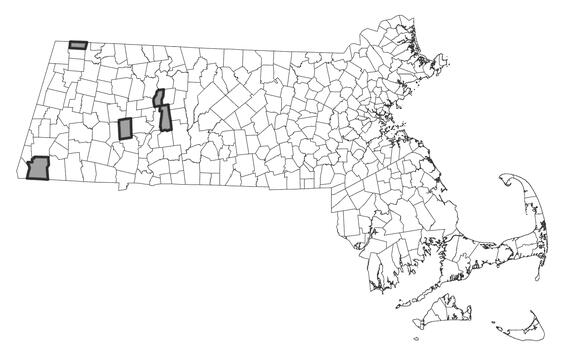- Scientific name: Cordulegaster erronea
Species of Greatest Conservation Need (MA State Wildlife Action Plan)
Description

Male tiger spiketail
The tiger spiketail is a large, slender insect belonging to the order Odonata, suborder Anisoptera (the dragonflies), and family Cordulegastridae (the spiketails). The spiketails are a small group of dragonflies named for the females long, spike-like subgenital plate used for ovipositing. Clubtails are further distinguished from other dragonflies by their large size, contrasting yellow and dark markings and eyes that touch at a point or slightly separated. The tiger spiketail is a member of the genus Cordulegaster (subgenus Zoraena). In males and females, eyes are bright green with black face stripes. The thorax is black with yellow dorsal stripes, spots between wings, and two lateral stripes. The abdomen is black with yellow rings at base of segments one through eight. Females are stockier than males and possess subgenital plate extending beyond the abdomen.
Adult tiger spiketails range from 65-76 mm (2.6-3 in) in length. Fully developed nymphs range from 34-38 mm (1.3-1.5 in).
Three other more common species of Cordulegaster occur in Massachusetts (C. diastatops, C. maculata, C. obliqua) and are similar in appearance. Tiger spiketail is the only spiketail in Massachusetts with a yellow ringed abdomen. The species may also be confused with male zebra clubtail (Stylurus scudderi) which also has a dark body with a yellow-ringed abdomen, but tiger spiketail posterior segments are not enlarged to produce a club. See keys in Tennessen (2019) for identification of nymphs and exuviae.
Life cycle and behavior

Note, nymphs are present year-round.
Tiger spiketails are elusive but parts of its life history have been studied. The egg and nymph life stages are fully aquatic. The nymphs are predators, feeding on a wide variety of aquatic insects and other organisms (e.g., tadpoles). Nymphs spend much of their time burrowing in sandy and finer substrates of depositional habitats that provide them protection from predators and camouflage to catch prey. Nymphs undergo several molts (instars) for at least 3-4 years until they are ready to emerge as winged adults. When ready to emerge, typically in late June, the nymphs crawl out onto nearby tree trunks and branches where they undergo transformation to adults (a process known as eclosion). The cast nymphal exoskeletons, known as exuviae, are identifiable to species and can be a reliable, useful means to determine species presence.
As soon as the freshly emerged adults are dry and the wings have hardened sufficiently, they fly off to seek refuge in the vegetation of adjacent uplands. Here, they spend several days or more feeding and maturing, before returning to their breeding habitats. Spiketails can be found in forested uplands in the canopy, forest openings, or fields, seeking prey. When at rest, they typically perch at 45-degree angles or hang straight down from a branch. In Massachusetts, the species probably breeds from July through August. Mature males can be observed patrolling along the stream corridor just over the water seeking females, prey items, and warding of other males. Females spend little time around the breeding habitat, often in trees, except during the brief time when they are ready to mate and lay eggs. When mating is completed, the female alone deposits her eggs into the streambed by vertically tapping her abdomen rapidly into the water and substrate with use of her extended subgenital plate.
Based on more southernly populations, tiger spiketails likely emerge from streams in late June and flying into September.
Distribution and abundance
The tiger spiketail range extends from Louisiana north along Appalachia into New Hampshire and Vermont and as far west as Illinois. Massachusetts lies at its northernly range edge and has been recently documented in the Hoosic, Housatonic, and Middle Connecticut River watersheds. Species occurrences are very few with 5 documented sites. This likely reflects a combination of limited survey effort in its suitable habitat (e.g., forested, moderate-high gradient streams), low detection rates, potentially small population sizes, or lack of suitable habitat. The species status remains uncertain in Massachusetts.

Distribution in Massachusetts.
1999-2024
Based on records in iNaturalist, Odonata Central, and Natural Heritage databases.
Habitat
Tiger spiketail inhabits spring and seepage-fed small streams with forested riparia. Nymphs are found in sand and gravel deposits in pools and along stream edges. The adults inhabit surrounding forests and along stream corridors.
Healthy habitats are vital for supporting native wildlife and plants. Explore habitats and learn about conservation and restoration in Massachusetts.

Small, cold-water, low gradient stream likely suitable for tiger spiketail.
Threats
Degradation of water quality, alteration of streamflows, and upland habitat loss are primary threats to tiger spiketail. Potential threats to water quality include pollution and sewage overflow, salt and other road contaminant run-off, and siltation from construction or erosion. The disruption of natural flow regimes from water withdrawal, damming, and stream channelization may have a negative impact on populations. Warming stream temperatures and prolonged drought from climate change may reduce suitable habitat. Additional threats include illegal or accidental industrial discharge and hardening of channel banks and siltation.
Conservation
Survey and monitoring
Standardized and targeted surveys for tiger spiketail are needed to determine its status in Massachusetts. Surveys should target historical and new stream sites to determine species occupancy and population status, particularly in western Massachusetts. Surveys for exuvia and adults are likely to be more effective for detection compared to either one alone. Exuviae surveys should target the species emergence period in late June to maximize detection. Adult surveys should target stream and streambank habitats during their flight period during standardized weather and time windows to maximize species detection. Multiple site visits (e.g., ≥3) may be required to detect this species. Routine monitoring of prioritized sites is needed to estimate occupancy trends overtime.
Management
Upland and stream habitat protection is critical for the conservation of tiger spiketail. Protection of forested upland borders of these small stream systems, and upland connections between them, are critical in maintaining suitable water quality and are critical for feeding, resting, and maturation. Development of these areas should be discouraged, and the preservation of remaining undeveloped uplands should be a priority. Alternatives to commonly applied road salts should tested to minimize freshwater salinization. Hardened and channelized stream segments should be restored to promote natural sediment dynamics.
Research needs
Through standardized surveys, effort is needed to define habitat requirements, distribution, relative abundance, and potential breeding sites in Massachusetts. Research effort is needed to estimate detection and occupancy rates and how other environmental variables (e.g., sample timing, weather) affect these rates. Other research efforts include projections of species distribution under climate change scenarios and climate vulnerability analysis in Massachusetts, since this species occupies smaller streams and seeps. Further, since Massachusetts is at its northern range limit, this species may occur at more sites in the future. Documentation of a potential northward distribution shift in Massachusetts will be important for the conservation of this regionally rare dragonfly.
References
Glotzhober R.C. 2006. Life history studies of Cordulegaster erronea Hagen (Odonata: Cordulegastridae) in the laboratory and field. Bulletin of American Odonatology 10(1):1-18.
Lam, E. Dragonflies of North America. Princeton NJ: Princeton University Press, 2024.
Moskowitz D., and M.L. May. 2017. Adult tiger spiketail (Cordulegaster erronea Hagen) habitat use and home range observed via radio-telemetry with conservation recommendations. Journal of Insect Conservation 21:885-895.
Moskowitz D., and M.L. May. 2019. Nymph ecology, habitat, and emergence-site selection of Cordulegaster erronea Hagen (tiger spiketail dragonfly) in New Jersey with implications for conservation. Northeastern Naturalist 26(1):141-154.
Nikula, B., J.L. Ryan, and M.R. Burne. A Field Guide to the Dragonflies and Damselflies of Massachusetts. 2nd ed. Massachusetts Natural Heritage and Endangered Species Program, 2007.
Paulson, D. Dragonflies and Damselflies of the East. Princeton NJ: Princeton University Press, 2011.
Tennessen, K. Dragonfly Nymphs of North America: An identification guide. Springer, 2019.
Contact
| Date published: | April 3, 2025 |
|---|